Olympus EVOLT E-500By: Shawn Barnett and Dave Etchells8.0 megapixels, ZUIKO DIGITAL lens mount, digital SLR design, and loads of features! <<Reference: Datasheet :(Previous) | (Next): E-500 Sample Images>> E-500 Imatest ResultsReview First Posted: 09/25/2005, Updated: 12/05/2005 |
Detailed analysis of the Olympus eVolt E-500 images, from Imatest(tm)
I've recently begun using Norman Koren's excellent "Imatest" analysis program for quantitative, thoroughly objective analysis of digicam test images. I highly commend it to our technically-oriented readers, as it's far and away the best, most comprehensive analysis program I've found to date.
My comments below are just brief observations of what I see in the Imatest results. A full discussion of all the data Imatest produces is really beyond the scope of this review: Visit the Imatest web site for a full discussion of what the program measures, how it performs its computations, and how to interpret its output.
Here's some of the results produced by Imatest for the Olympus E-500:
Color Accuracy
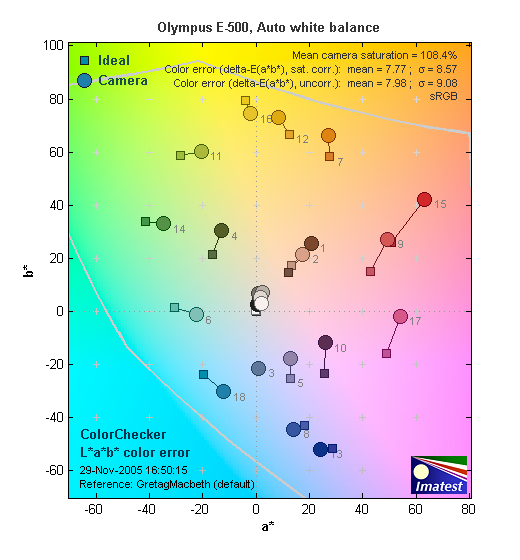
The Olympus E-500 showed very good hue accuracy, but like many digital cameras oversaturated bright reds quite a bit. Its images looked bright and vibrant, but reds in particular looked a little hot. Average saturation was 108.4% (oversaturated by 8.4%, mostly in the reds), average "delta-E" color error was 7.98, a little on the high side, but not visually apparent in the images we shot. (Hue error, after correction for saturation.)
Color Analysis
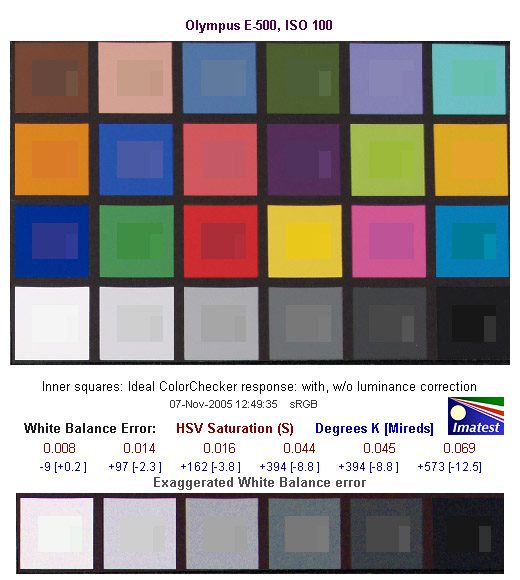
These images show the color behavior of the E-500 more directly. In each color swatch, the outer perimeter shows the color as actually captured by the camera, the inner square shows the color after correcting for the luminance of the photographed chart (as determined by a 2nd-order curve fit to the values of the gray swatches), and the small rectangle inside the inner square shows what the color should actually be, based on perfect rendering to the sRGB color space.
Gray Patch Tone and Noise Analysis
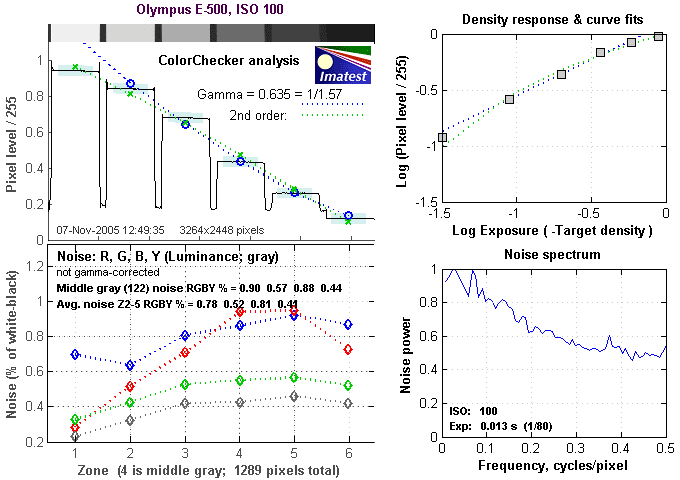
There's a lot in this particular graph, a lot more than I have room to go into here. Bottom line, the E-500's noise levels are low at low ISOs, and the noise spectrum at low ISOs is weighted toward the high frequency quite a bit. This translates in finer-grained noise which is generally less objectionable, but since the absolute levels are so low, the fine grain structure doesn't make much difference one way or the other.
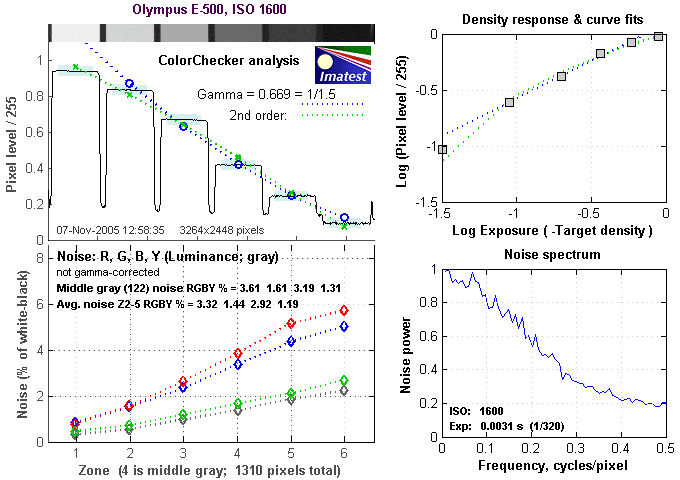
Here's the same set of noise data at ISO 1,600. High-ISO image noise is perhaps the E-500's Achilles' heel. The noise levels increase, although numerically they're not actually all that high compared to other cameras (see the chart below). The frequency content changes markedly though, as can be seen in the Noise Spectrum plot in the lower right, which is heavily weighted toward the lower-frequency side of the plot.

This chart compares the Olympus E-500's noise performance over a range of ISOs against that of other cameras. As you can see, the E-500's numeric noise levels are actually quite competitive with those of the Canon Digital Rebel XT. This is quite surprising though, because the Rebel XT absolutely blows away the E-500 visually at ISO 1600, perhaps because what noise is present in the XT's images is very fine-grained, so you tend not to notice it as much. What's not shown here is both the grain pattern of the noise, as well as how the camera trades off noise with subtle subject detail. The E-500 does quite well with this latter issue, striking a good balance between reducing noise and preserving subtle detail. Overall, an impressive performance, quite competitive with many of the d-SLRs it competes with.
Dynamic Range Analysis
A key parameter in a digital camera is its Dynamic Range, the range of brightness that can be faithfully recorded. At the upper end of the tonal scale, dynamic range is dictated by the point at which the RGB data "saturates" at values of 255, 255, 255. At the lower end of the tonal scale, dynamic range is determined by the point at which there ceases to be any useful difference between adjacent tonal steps. Note the use of the qualifier "useful" in there: While it's tempting to evaluate dynamic range as the maximum number of tonal steps that can be discerned at all, that measure of dynamic range has very little relevance to real-world photography. What we care about as photographers is how much detail we can pull out of the shadows before image noise becomes too objectionable. This, of course, is a very subjective matter, and will vary with the application and even the subject matter in question. (Noise will be much more visible in subjects with large areas of flat tints and subtle shading than it would in subjects with strong, highly contrasting surface texture.)
What makes most sense then, is to specify useful dynamic range in terms of the point at which image noise reaches some agreed-upon threshold. To this end, Imatest computes a number of different dynamic range measurements, based on a variety of image noise thresholds. The noise thresholds are specified in terms of f-stops of equivalent luminance variation in the final image file, and dynamic range is computed for noise thresholds of 1.0 (low image quality), 0.5 (medium image quality), 0.25 (medium-high image quality) and 0.1 (high image quality). For most photographers and most applications, the noise thresholds of 0.5 and 0.25 f-stops are probably the most relevant to the production of acceptable-quality finished images, but many noise-sensitive shooters will insist on the 0.1 f-stop limit for their most critical work.
The image below shows the test results from Imatest for the Olympus E-500.
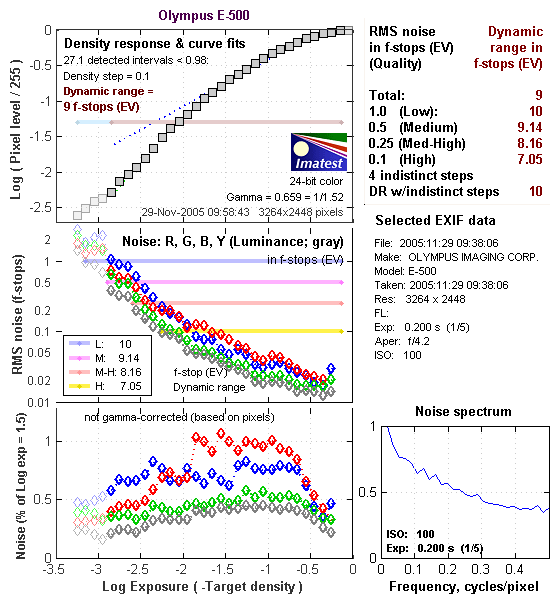
These results are fine, about mid-range when compared to many digital SLRs. As usual though, Adobe Camera Raw is able to extract quite a bit more dynamic range from the E-500's RAW files (provided that the original image is significantly overexposed; in this case by about two-thirds of a stop), as seen below.
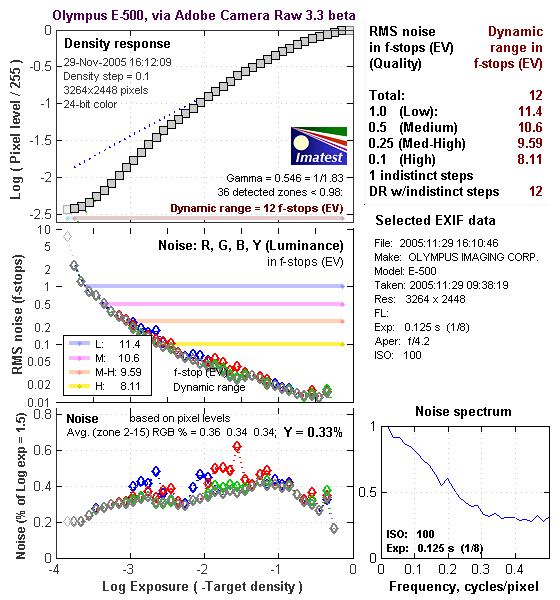
With that as background, here's how the Olympus E-500 performed, and how it compares to various digital SLRs that we also have Imatest dynamic range data for. (Results are arranged in order of decreasing dynamic range at the "High" quality level.):
| Dynamic Range (in f-stops) vs Image Quality (At camera's minimum ISO) |
||||
| Model | 1.0 (Low) |
0.5 (Medium) |
0.25 (Med-High) |
0.1 (High) |
| Fujifilm S3 Pro (Via Adobe Camera Raw 2*) |
12.1 | 11.7 | 10.7 | 9.0 |
| Canon EOS-1Ds Mark II (Via Adobe Camera Raw*) |
11.2 | 10.3 | 9.4 | 8.14 |
| Olympus E-500 (Via Adobe Camera Raw 3.3b*) |
11.4 | 10.6 | 9.59 | 8.11 |
| Fujifilm S3 Pro | -- | 9.9 | 9.4 | 7.94 |
| Olympus E-500 (Via Adobe Camera Raw 3*) |
10.7 | 9.97 | 8.90 | 7.46 |
| Nikon D50 | 10.7 | 9.93 | 8.70 | 7.36 |
| Canon EOS 20D | 10.3 | 9.66 | 8.85 | 7.29 |
| Canon Digital Rebel XT | 10.3 | 9.51 | 8.61 | 7.11 |
| Olympus E-300 | 10.8 | 9.26 | 8.48 | 7.07 |
| Olympus E-500 | 10 | 9.14 | 8.16 | 7.05 |
| Canon EOS-1Ds Mark II (Camera JPEG) |
10.3 | 9.38 | 8.6 | 7.04 |
| Canon Digital Rebel | 10.1 | 9.11 | 8.47 | 6.97 |
| Pentax *istDs | 10.2 | 10 | 8.87 | 6.9 |
| Nikon D2x | -- | 8.93 | 7.75 | 6.43 |
| Olympus E-500 | 9.83 | 8.95 | 7.86 | 6.13 |
| Nikon D70S | 9.84 | 8.69 | 7.46 | 5.85 |
| Nikon D70 | 9.81 | 8.76 | 7.58 | 5.84 |
| * Adobe Camera Raw generally produces the greatest measured dynamic range when the original image is significantly overexposed. (+2/3 stop or more) | ||||
The results shown in the table are interesting. One of the first things that struck me when I initially looked at all the data, was that here again, purely analytical measurements don't necessarily correlate all that well with actual photographic experience. There's no question that the Fuji S3 Pro deserves its place atop the list, as its unique "SR" technology does indeed deliver a dramatic improvement in tonal range in the highlight portion of the tonal scale. I was surprised to see the analytical results place the Olympus eVolts' as highly as they did, given that our sense of these camera's images has been that that they were in fact noisier than those of many other d-SLRs that we looked at. In the other direction, I was quite surprised to see the Nikon D2x place as low on the listings as it did, given that we found that camera's shadow detail to be little short of amazing.
One thing that's going on here though, is that we tested each camera at its lowest ISO setting, which should produce best-case noise levels. This is in fact what many photographers will be most interested in, but it does perhaps place the Nikons at a disadvantage, as their lowest ISO setting is 200, as compared to the ISO 100 settings available on most other models.
In the case of the Olympus E-500, it seems that its dynamic range is about average, at least based on this particular test. This agrees somewhat with our subjective experience, as its handling of harsh highlights and deep shadows was about on par with many competing cameras.
Bottom line though, I think you have to take the figures here with a grain of salt, and look at actual images with your own eyes to see what you make of each camera's tonal range and noise levels. We'll continue performing these dynamic range tests on the digital SLRs that we review, but (just as with the laboratory resolution target results), we suggest that you not rely on them exclusively for making your purchase decisions.
The chart above shows consolidated results from spatial frequency response measurements in both the horizontal and vertical axes. The "MTF 50" numbers tend to correlate best with visual perceptions of sharpness, so those are what I focus on here. The uncorrected resolution figures are 1533 line widths per picture height in the horizontal direction (corresponding to the vertically-oriented edge), and 1512 along the vertical axis (corresponding to the horizontally-oriented edge), for a combined average of 1522 LW/PH. Correcting to a "standardized" sharpening with a one-pixel radius changed the numbers relatively little, producing an average of 1593 LW/PH. Both sets of numbers are pretty much in line for an 8-megapixel SLR.
For the real techno-geeks, the two plots below show the actual edge response of the Olympus E-500, for horizontal and vertical edges. Here, we can see that the E-500's default sharpening is probably responsible for a slight coarseness to its images, resulting in a pronounced "bump" on the bright side of the edge. With the default sharpening as shown here, we see that the cause of this coarseness is the overshoot in the edge profile, and the distance that it extends away from the edge itself. (On the order of two pixels.) Unfortunately, the E-500's Low sharpening option doesn't really turn off the sharpening, it just reduces the height of the bump in the edge profiles. As a result, you can't get much more detail out of the E-500's images by shooting at low sharpness and then applying strong/tight unsharp masking in Photoshop(tm) later.
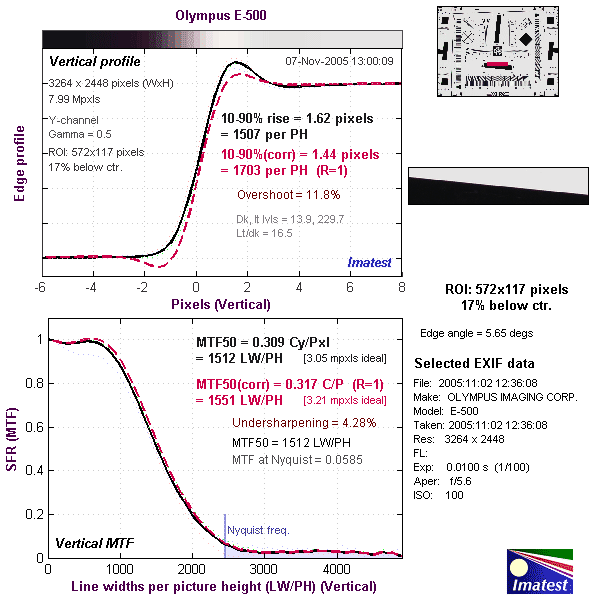

Reader Comments! --> Visit our discussion forum for the Olympus EVOLT E-500!
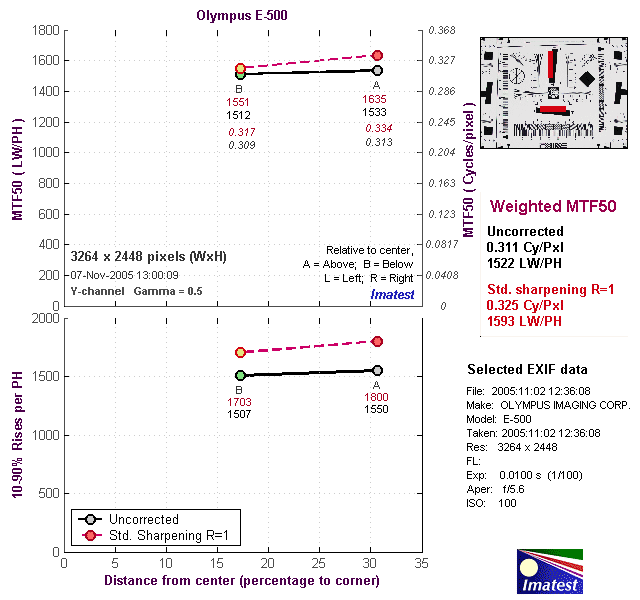

Follow Imaging Resource: